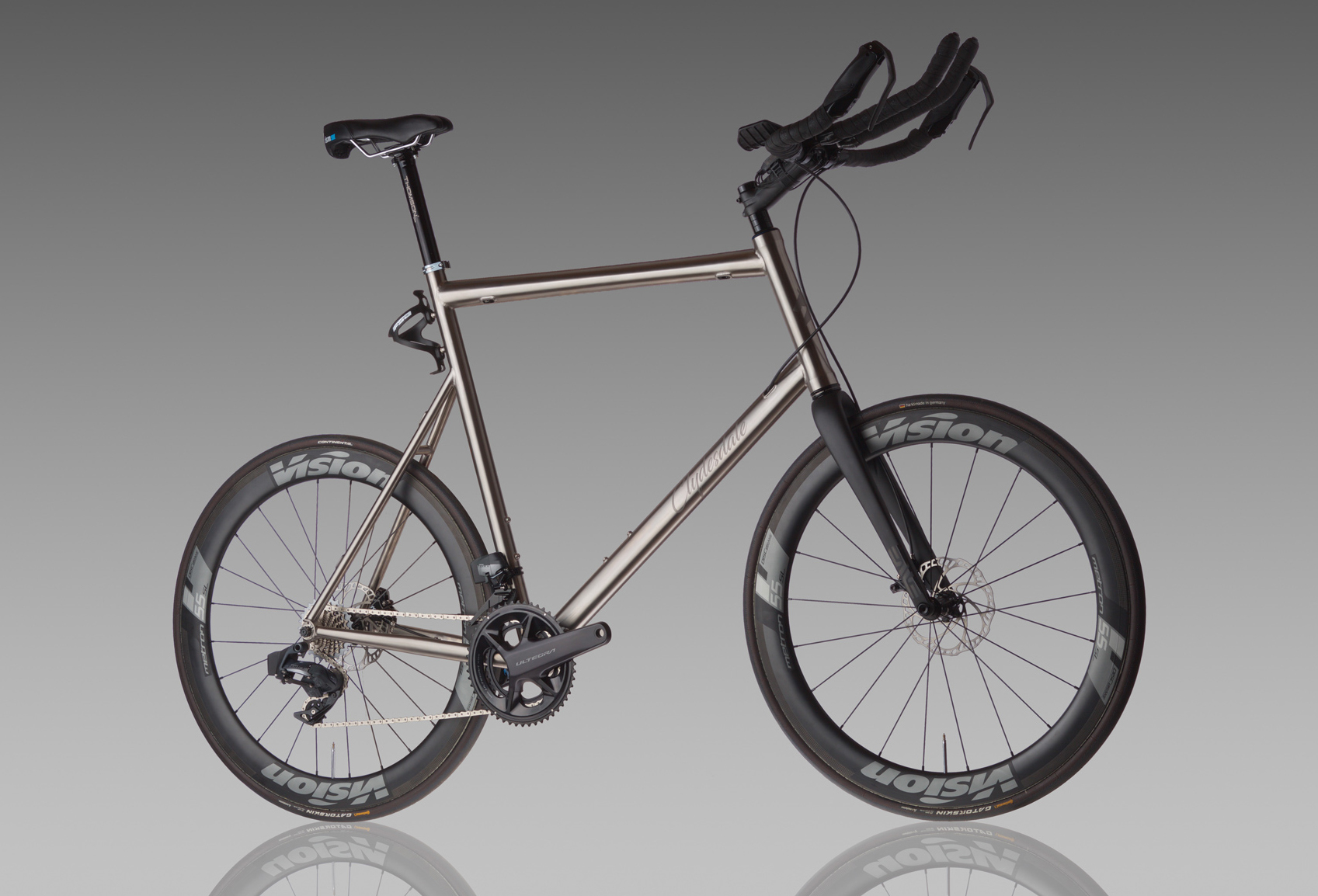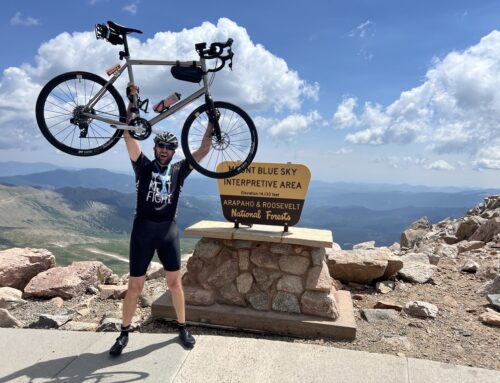By Lennard Zinn
Tall triathletes know that smaller athletes have inherent advantages over them on the run portion of the event and that it’s advantageous to gain as much time on lightweight runners as possible before donning running shoes. The Clydesdale Tri is designed to do just that for riders who are too tall to fit on stock-sized triathlon bikes from any other brand. The Tri also offers tall riders more speed in time trials.
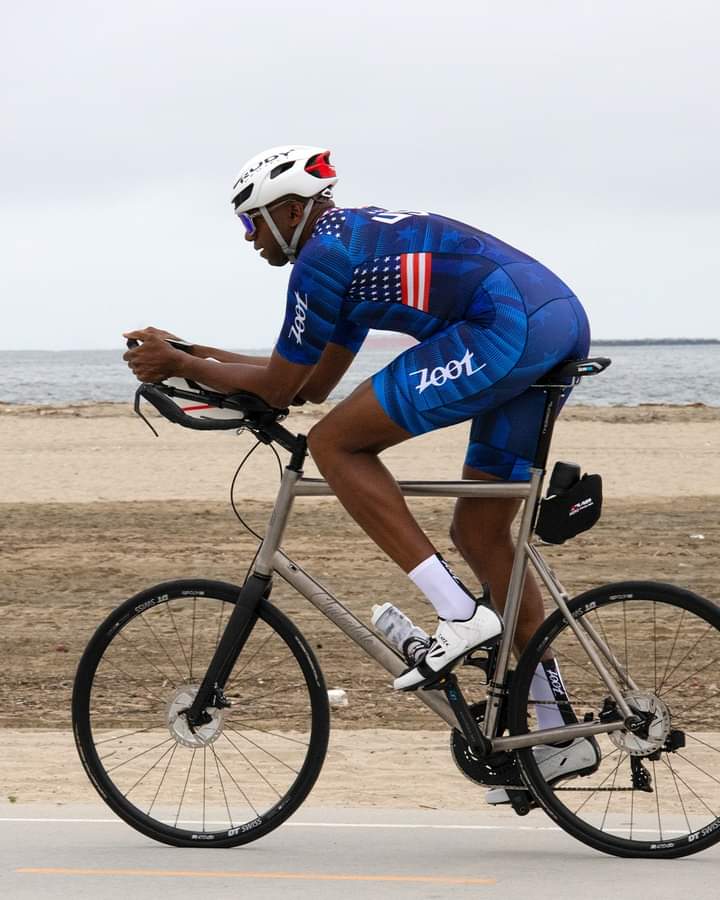
Chad McRae on his Clydesdale Triathlon bike
Going fast in a triathlon or time trial requires more than a sleek-looking aero bike; it also requires a good fit on a bike that supports the rider so comfortably in an aerodynamic riding position that he or she can hold that position without moving around to relieve discomfort when pedaling hard. Big riders naturally produce a lot of power, and their large bodies also create a lot of wind resistance. Physics tells us that a big rider has a speed advantage over smaller riders on a flat course provided they can drop their aerodynamic drag sufficiently. The Clydesdale Tri allows them to take that advantage.
Physics demonstrates that aerodynamic drag on an object increases exponentially with its speed; in fact, the drag force of the air pushing back on a moving object goes up as the cube of the object’s velocity. This is why gas mileage in a car drops when the car is driven faster. Otherwise, in the absence of aerodynamic drag (i.e., in a vacuum, like in outer space), there is a direct relationship between power and speed without an increase in energy consumption per mile traveled.
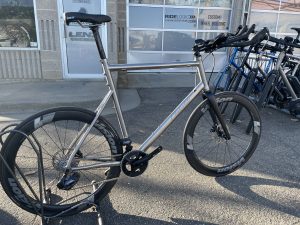
Working in favor of the big rider on a flat course are two basic principles of physics. One is that the volume of an object is proportional to a dimension of the object multiplied by itself twice; for example, the volume of a sphere is proportional to its radius cubed, the volume of a cube is its width cubed, and the volume of a cylinder is proportional to its length times the square of its radius.
The other principle working in favor of the big rider on a flat course is that the area of a surface is proportional to a dimension of the surface multiplied by itself only once; for example, the area of a circle is proportional to its radius squared, the area of a square is equal to its width squared, and the area of a rectangle is its length times its width.
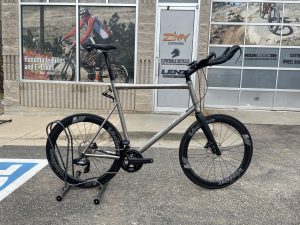
The good news from physics for the big rider is that aerodynamic drag is proportional to surface area while human power output tends to be proportional to body volume. In other words, assuming a similar level of fitness, a bigger rider can produce more power than a smaller one related to the cube of how much bigger they are, whereas their wind drag will go up only related to the square of how much bigger they are. The Clydesdale Tri makes the most of this inherent advantage a big rider has by positioning him to block less wind as well as be comfortable on the bike, pedaling efficiently.
Over 80% of the aerodynamic drag of a bike and rider is the drag on the rider’s body, and around half of the remaining drag is created by the wheels. Since a big rider can have just as aerodynamic of wheels as a small rider, that’s a wash, which brings us to the frame. You can easily see that a titanium Clydesdale Tri frame is not as aerodynamic as, for example, a Specialized Shiv or a Cervelo P5. On the other hand, those bikes will not fit a 6’4” or taller rider; no company makes the huge investment in the molds required to make each size of a carbon frame for riders whose height makes them a tiny percentage of potential customers. What the titanium Clydesdale Tri offers is to support a rider who is too tall for those bikes in the most aerodynamic and pedaling-efficient position possible without giving away any of his power in the flexing of flat frame tubes.
You know that if you flatten a toilet paper tube, you can easily bend it, whereas it resists bending when in its original round shape. Furthermore, tubes that run parallel to the wind have no difference in drag if they are flat or round. So, the oversized, horizontal titanium top tube and chainstays of the Clydesdale Tri resist the large twisting and bending forces put into them by big riders without adding any extra wind resistance. In contrast, the seatstays and down tube have a teardrop cross section to reduce aerodynamic drag, since, unlike the top tube and chainstays, they cut across the wind; the seatstays also meet the seat tube lower down to get them more out of the wind. The long, oversized head tube and fork with a consequently long steering tube of course create more wind drag than a smaller aero carbon frame and fork, but this tradeoff is tiny compared to the huge aerodynamic benefit of putting the tall rider in a low-drag and comfortable pedaling position.
For hilly or mountainous road and gravel riding, crank lengths on the Clydesdale Draft and Team gravel road bikes are in the 20-21% range of the rider’s leg length, a similar ratio to what smaller Tour de France riders use. Testing and customer testimonials has always shown this to result in faster climbing. However, in a flat time trial or triathlon, aerodynamic drag so completely dwarves any other forces the rider must overcome that the rider will be faster by giving up a small amount of power to gain a large drop in aerodynamic drag. That’s the philosophy behind shortening the cranks on the Tri to around 18% of the rider’s leg length. The lower height of the knees at the top of the stroke (by a full 6cm when comparing a 210mm road crank on a 3XL Clydesdale Draft or Team with the 180mm cranks on a 3XL Clydesdale Tri) allows the rider to get much lower, greatly reducing his wind resistance. Because of that cubed relationship between speed and wind drag, a small reduction in wind resistance can create a large increase in speed and consequent big reduction in triathlon or time trial times without more energy expenditure. Pedaling cadence is easily increased with shorter cranks, and, since power output equals pedaling torque multiplied by cadence, this results in little power reduction with the reduced pedaling torque caused by the shorter cranks.
The Tri’s 78-degree seat-tube angle and cranks on the short end for such tall riders support the tall triathlete or time trialist in a low, aerodynamic position with the back close to horizontal and hip angle open to prevent the thighs banging into the belly and chest and impinging the hip muscles (or worse, the knees flaring out in the wind to avoid these impingements). This results not only in faster bike splits but also make it easier to get off and run afterward. Optimal top-tube and head-tube lengths for tall riders make the elbow pads and aero bars support the rider comfortably in an aero position with easy ability to breathe; the front-end geometry makes the bike super stable, requiring no extra effort or focus on steering and control; the ISM saddle provides comfort despite the rider’s pelvis being tipped forward to allow the angle of the back to be low and aerodynamic, and the forgiving titanium tubes dampen road roughness.
While it may not look like a sleek, carbon aero bike, the Clydesdale Tri is the fastest stock triathlon/time-trial bike for a rider taller than 6’3”. Try one and you’ll see.

